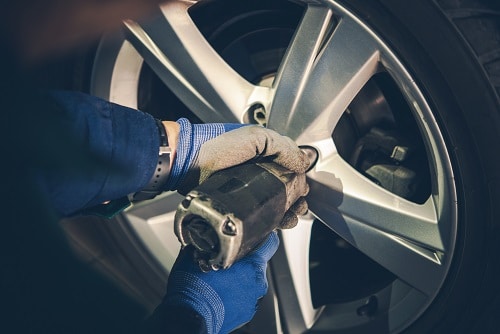When To Book A Tire Change Near Me: 4 Signs It’s Time For A Replacement
December 15, 2021
Tires

As is the case with most auto repairs, if you’re trying to save money on tire service, early detection is key. To help you spot and fix minor issues before they become major expenses, today’s post shares 4 subtle signs it’s time to book a tire change near you.
Read on to learn more, or contact your local TIRECRAFT to speak directly with a tire change expert near you.
When To Book A Tire Change Near Me: 4 Signs You Shouldn’t Ignore
1. The Tire Warning Light Comes On
All vehicles manufactured after 2008 will have a tire-pressure monitoring system (TPMS), which uses sensors to continuously monitor tire inflation levels and warn you with a dashboard symbol when pressure drops dangerously low.
If you spot the TPMS warning symbol, which looks like a “U”-shape with an exclamation point in the middle, it doesn’t automatically mean you’re on the hook for a tire replacement, but it does mean something’s awry. Either your TPMS system is on the fritz, or at least one of your tires is underinflated.
Underinflation is a big problem, as it puts too much of the tire’s surface area in contact with the road, increasing friction, heat, and wear. In fact, it’s one of the leading causes of tire failure in Canada.
In most cases, adding air to your tires will do the trick. But sometimes it can indicate that a tire repair or replacement may be needed.
To get to the root of the problem, get in touch with our tire change technicians. We can add air, repair punctures or leaks, and help you find an affordable replacement set as required. And if it turns out that the TPMS system is malfunctioning, we can help you set it straight.
2. Low Tire Tread And/Or Uneven Wear
When it comes to tire performance, the condition of the treads, those stubbly bumps and grooves on our tires where the rubber meets the road, is incredibly important. Low treads means low control, high risk, and high fuel costs, too.
Most tire experts recommend 6/32 inch tread depth, or about 4.7mm. If your treads are worn beyond that, it’s time to book a tire change near you—and, considering the state of your treads, the closer the better!
Additionally, as you examine your treads, take a moment to ensure that all tread wear is roughly even. If you notice any imbalances, there could be other issues at play.
Our technicians can help you find the right replacement set, and also identify signs of any other problems related to your abnormal tread wear, such as underinflation, misalignment, or damaged tires.
3. Tire Vibration
All vehicles vibrate, especially on rough roads, but serious shaking should be cause for concern. Most often, excessive vibration is caused by tire misalignment and/or damaged suspension systems, but sometimes a simple tire change can be all you need to ensure a smooth ride.
4. It Has Been Over 5 Years Since Your Last Tire Change Or Replacement
All tires have a tentative expiration date, which varies slightly depending on the product type and manufacturer in question. That said, most experts agree that all tires should be checked, if not replaced, after 5 years of use, and that all tires should be replaced after 10 years of service. If you’re nearing these expiration dates, get in touch with our tire change technicians.
Back

